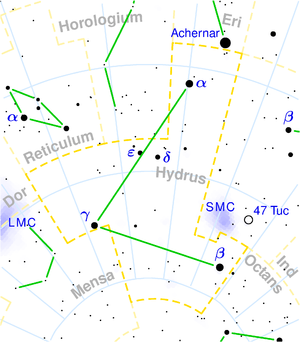 A minor constellation near the south celestial pole, near Achernar of Eridanus. It takes the form of an isosceles triangle that lies between the Large and Small Magellanic Clouds. The Hydrus is not visible at our latitudes.
A minor constellation near the south celestial pole, near Achernar of Eridanus. It takes the form of an isosceles triangle that lies between the Large and Small Magellanic Clouds. The Hydrus is not visible at our latitudes.
β Hyi - A star similar to our Sun of spectral class G shining from a distance of 22 light years. Its diameter is twice that of the Sun, surface temperature reaches 6,300 K, and its mass is 1.4 times that of our Sun. It is the brightest star in the constellation, with an apparent magnitude of 2.8.
α Hyi - A yellow star with a brightness of 2.9 magnitude. It is located just 30 light-years away from Earth.
γ Hyi - The red giant of spectral class M2, which has a brightness of 3.2 mag, is located 214 light-years away from us.
VW Hyi - The star, well known to observers of the southern sky as a cataclysmic variable. During its quiet period, it shines with a brightness of 13th magnitude, but during its brightening, which occurs once a month, it brightens to 8th magnitude.
φ Hyi - An optical double star distinguishable under good conditions with the naked eye. Both components have nearly the same brightness - 5.4 mag and 5.5 mag. These red giants are located at a distance of 740 and 470 light-years.
NGC 1511
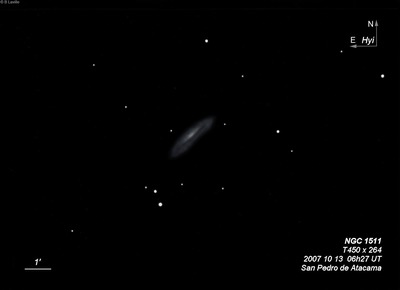
John Herschel discovered NGC 1511 = h2608 on 2 Nov 1834 and described "pB; mE; vgbM; 90" l; pos 125.5?." His position and description matches ESO 055-004 = PGC 14236.
The galaxy was sketched by Joseph Turner in 1876 (unpublished plate II, figure 12 and 13) using the Great Melbourne Telescope and later by Pietro Baracchi.
600/800mm - 24" (4/4/08 - Magellan Observatory, Australia): at 200x appeared fairly bright, fairly large, elongated 3:1 NW-SE, ~2.5'x0.8'. Contains a bright, elongated core with a small very bright nucleus. Two stars mag 14-15 stars bracket the galaxy just 54" E and 1.3' W of center and just north of the center. The northeast flank of the galaxy appears slightly brighter and more sharply defined and there is an impression of a dust lane on the south side. At 260x the galaxy has a mottled appearance and is slightly warped or asymmetric at the tips. A mag 10.8 star lies 3.5' SSE and a fainter edge-on NGC 1511A is in the field 11' SSE. The companion is a fairly faint, moderately large, edge-on 7:2 WNW-ESE, 1.5'x0.4', broadly concentrated with a slightly bulging core. NGC 1511 is a member of a small group that includes NGC 1473, NGC 1511A and NGC 1511B.
Notes by Steve Gottlieb
NGC 1466
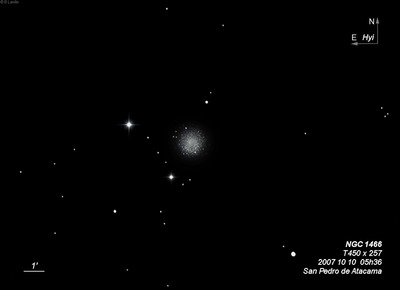
John Herschel discovered NGC 1466 = h2590 on 26 Nov 1834 and recorded "F, irregularly round, glbM, 30", has a * 7th mag foll, and others near." On a second sweep he notes "Viewed past meridian; found in place; pB, R, gbM, 30" dia."
400/500mm - 18" (7/9/02 - Magellan Observatory, Australia): this outlying globular of the LMC is known to be one the oldest LMC clusters. At 128x it appeared moderately bright, fairly small, round, 2' diameter. There was no resolution except for a single faint star at the south edge but the surface brightness was high. This cluster was fairly prominent and very easy to find as it is situated 4' WSW of mag 6.3 HD 241888 (CT Hydri) and 2.2' NNW of a mag 9 star.
600/800mm - 30" (11/4/10 - Coonabarabran, 264x): bright, moderately large, round, 2.5' diameter. Appeared mottled with some extremely faint stars resolved in the halo. The only brighter resolved star is on the south side of the halo. The view is somewhat hampered by mag 6.3 CT Hydri just 4' ENE and a mag 9 star 2.3' SSE. NGC 1466 is one of the 15 bona-fide ancient GC's in the LMC.
Notes by Steve Gottlieb
NGC 646
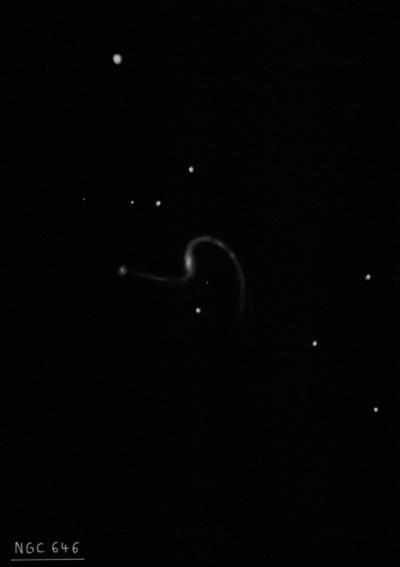
The companion, PGC 6014, appeared faint, very small, round, 12" diameter. It was easily seen close east of NGC 646 [0.9' separation between centers]. The pair is located 8' NE of mag 9.5 HD 10080.
John Herschel discovered NGC 646 = h2434 on 2 Nov 1834 and logged "vF, irregularly round, vglbM." His position matches this double system.
600/800mm - 25" (10/16/17 - OzSky): this interacting double system (NGC 646 + PGC 6014) was resolved at 244x, though more cleanly viewed at 397x. NGC 646, the brighter and larger western galaxy, appeared fairly faint, fairly small, roundish, 24" diameter, weak concentration. I didn't notice the very low surface brightness arms that are tidally stretched (one extends to to PGC 6014).
Notes by Steve Gottlieb
NGC 602
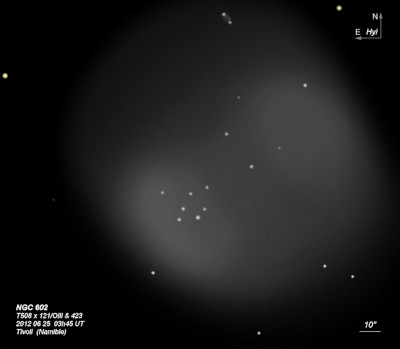
James Dunlop discovered NGC 602 = D 17 = h2421 on 1 Aug 1826 with his 9-inch f/12 speculum reflector and described "a faint round nebula, about 2' diameter, a very little brighter in the middle, with some minute stars in it." Dunlop's position is just 3' E of this SMC cluster.
On his first sweep on 11 Apr 1834, John Herschel logged "pB, S, irregularly round, psb but not to the middle, but rather to a point near the southern edge. Is decidedly resolved, and has scattered stars. (This is an outlier of the Nubecula Minor)". On a second sweep he called it "B, R or lE, psbM to a star; has also a star involved which looks like a second nucleus and several small stars about it." JH credited Dunlop with the discovery.
Joseph Turner observed this object on 26 Jan 1879 with the 48" Melbourne Telescope and noted there was clearly a double star in the center.
400/500mm - 18" (7/6/02 - Magellan Observatory, Australia): at 228x, a knot of stars is embedded in a 3' fairly bright oval nebula (Henize N90). On closer inspection the knot of stars is offset to the SE side of the nebula. At 171x and UHC filter, the nebulosity is fairly bright and clearly locally brighter on the SE end around the knot of stars. A weak dark rift, running SW-NE, separates the fainter portion of nebulosity to the NW. This nebulous cluster is an outlying member of the SMC.
600/800mm - 25" (10/17/17 - OzSky): at 244x; NGC 602 is a large nebulous cluster (SMC-N90) that was clearly brighter on the southeast end. The total size is ~3' with the southeast end fairly bright, fairly large, irregular shape. A tight knot of three stars is near the center. Additional stars are involved near the edges. A weak dust lane was on the west end oriented SW-NE, separating the roundish western section. A mag 13.8 star (O3-type Sk 183) is involved just west of the dust lane. This star is one of the massive O-type stars in the SMC and the dominant ionizing source of the nebula. The two portions are separated (barely) without a filter but tangent when I added a NPB filter. A mag 12.5 star is off the SW side (1.8' from center) and a mag 13 star is off the north side, 2.2' NNW of center. NGC 602, along with N89 and N88 to the northwest, are situated along the boundary of SMC-1 (also called SMC-SGS 1), the only supergiant shell in the SMC, with a diameter of ~1°..
SMC-N89, located 20' NW, is fairly faint, large, roundish, irregular glow, ~3.5' diameter. At the northeast end are four mag 11.5/12/12.5/13 stars (part of Hodge association 67) in a near equilateral triangle with a 4th star at the center and a 12th mag star is at the E or SE end of the nebulosity. Lindsay 104 is a very faint, unresolved patch (cluster) just southwest of the four distinctive stars. Situated at the western boundary of SMC-1.
SMC-N88, located 33' NW, is dominated by a Highly Ionized Blob (HEB) of only 3.5" diameter and mag ~12.5. At 244x + NPB filter it appeared as a bright "star" or quasi-stellar object surrounded by faint nebulosity on the east and south side. I assume there was a contrast gain with the filter as this dense, high-excitation object has a ratio of O III lines/H-beta > 10.5. The nebula is surrounded by Hodge Assoication 64 including a mag 14 star 2' E, two close mag 14 stars 1.8' SE and a mag 14.5 star 1' SSE. A mag 11.2 star (part of Hodge Associatin 65) lies 5.6' S. Situated at the NW edge of supershell SMC-1.
Notes by Steve Gottlieb